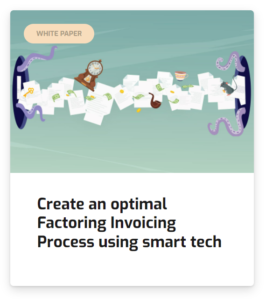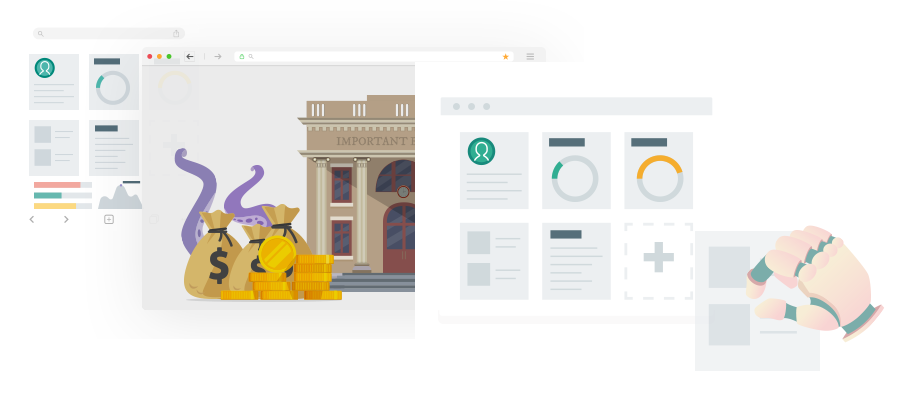In this article we will focus on three different user experiences and personas in the factoring process. The invoice is at the heart of a factoring business, and it touches all parts of the organisation. Factoring is quite unique in that it involves three different User Experience Cases (UXC), that also have different personas tied to them.
This article is part of our article series and whitepaper about the factoring invoicing process. We go through the whole process and how to design it using smart tech to automate manual repetitive tasks, gain deeper insights and increase control.
User Experience: Factoring Company
 The factoring company is the one owning and administrating the whole invoicing process. They’re responsible for the clients and debtors user experience.
The factoring company is the one owning and administrating the whole invoicing process. They’re responsible for the clients and debtors user experience.
In order to deliver the best UX and optimized process they need a good back-office system. The system should integrate with all necessary niche systems, compile the data and display a comprehensive overview, as well as giving the user operational
control and possibility to interact with the data.
#MANAGEMENT
Management in a factoring company wants direct access to KPIs like risk scores, financed amounts, invoice pipeline and limits. They also want tools to tweak the factoring process and subprocesses to further improve the KPIs. They want solid systems that can scale effortlessly with the business at a predictable price rate.
#OPERATIONS
These guys are all about control and eliminating manual repetitive tasks to free up their valuable time. The operations persona usually include credit handlers, sales and customer success.
The handlers are the backbone of the factoring business. They want smooth workflows for KYC, surveying and approving clients, debtors and invoices, making credit decisions, administrating distribution of invoices, answering questions and reporting.
Sales and Customer success wants easy access to on point and up to date records for their accounts. They focus on clients, financed amounts, trends, risks and fees.
#TECH
You usually recognize these guys by the 5-10 pencils in their checked shirt pocket, or their t-shirt with a pawky statement accompanied by an Alpaca or a Grumpy cat.
The tech team is not always represented in a factoring business. It depends on the scale and level of digitalization. If a company does not have their own tech team, the responsibility instead lies with the suppliers.
To keep the tech team satisfied you need Rest APIs, pre-built integrations, scalable architecture, cloud native solutions, great uptime, well-documented software, frequent releases, high level of security, and tech savvy suppliers that speak their language.
User Experience: Factoring Client
 This is the client of the factoring company. Their demands vary depending on the industry and company size.
This is the client of the factoring company. Their demands vary depending on the industry and company size.
Smaller businesses might only want to email their invoice to the factoring company, receive their money and forget about it. While larger corporations usually want a more self-serviced, scalable and automated process, with deeper insights and status updates.
#MANAGEMENT
The client’s management team has similar demands like the factoring management team. They want transparency and direct access to KPIs like financed amounts, fees and limits. They want solid solutions that can scale effortlessly with the business.
#OPERATIONS
Depending on the size of the client, the ones working with operation tasks, might be the same as the management team. Operations want control, overview, and smooth workflows.
If it’s a small business, they usually just want to send their invoice to the factoring company and get their money. However, they also appreciate self-service and the possibility to see status for their invoices, limits, and fees.
The operations team of a larger company has higher demands. They want automated invoice fetching & bookkeeping, pre-decision intel on invoices, control and overview of all their invoices and debtors, as well as a more seamless user experience for their debtors where the client’s brand is in focus.
#TECH
The tech team is – similar to the factoring company — not always represented in the client’s business. It depends on their scale and level of digitalization.
To keep the client tech team satisfied you need Rest APIs, pre-built integrations, great uptime, and high level of security.
 User Experience: Factoring Debtor
User Experience: Factoring Debtor
The debtors can be both businesses and consumers, and depending on which category they fall into, their demands look quite different.
#CONSUMERS
Consumers wants fast solutions with the possibility of hazzle free customer service. They prefer being able to pay the invoice directly via either bank transactions, credit card or other types of payment. They also appreciate having an overview of all their invoices and the balance digitally.
#BUSINESSES
Businesses prefer getting their invoices delivered directly to their ERP or accounts payable system. They don’t have the need for a separate portal with payment options. They too want hazzle free and direct customer service when needed.

Golden focus points for Factoring & Invoicing
When working with the invoicing process we have three golden focus points that helps us optimize the user experience and handling.
Overview
This focus point helps both management, operations and clients in their daily work. Since the invoicing process consist of so many steps and subprocesses, usually interconnected with several systems – overview is vital. To achieve this, synchronisation and harmonization of data is key. This is achieved through integrated systems and APIs.
Working with Overviews enables the factoring company to visualize a complete compilation of the portfolio, KYC data, risks, distribution of accounts receivable etcetera. The collected data can also be used to serve clients and give them full transparency regarding invoices, pricing, limits and distribution.
Centralised and harmonized data lays the foundation for the next two focus points: automations and actions.
Automation
Everything that can be done to minimize manual repetitive tasks, should be done. This is one of the big cost savers when a factoring company grows. It’s also the prerequisite to scale the business fast.
Everything from fetching, distribution, reminders, payments, debt collection and bookkeeping can be automated – adding up to months of saved manual labour for both the factoring company and their clients.
Automation is at its core based on interconnected systems, free-flowing data, and predefined rules. The next level of automation utilizes the first level and ads Artificial Intelligence and Machine Learning to not only automate, but also optimise the process.
In order to automate the invoicing process, you need to combine data flows from different systems with centralised and decentralised logic and rules. This also sets the stage for the last focus point: Actions.
Action
Some people are all action and no theory, and some are all theory and no action. This golden focus point is about combining them both to perfect the invoicing process.
Action leverages the power made possible from combining overview and automation. Actions can themselves be automated, and sometimes be totally independent from manual involvement.
Actions could be payment reminders, debt collection, matching of incorrect payments, optimizing distribution and payment profiles for debtors, approving invoices, changing invoices, and so much more.
 The difference an optimized flow makes
The difference an optimized flow makes
The impact a well-designed, automated, and optimized invoicing flow can have on your factoring business is substantial. Not only does it improve the day-to-day work for your operations and management team. It also affects your client’s business, as well as their debtors in a positive way.
As we’ve talked about before, factoring covers three different user experiences, and if done correctly this can create positive effects throughout the UX chain.
Saved time
- Automate manual repetitive tasks
- Simplify administrative tasks and workflows
- Integrate systems, remove manual imports & exports
Better Liquidity
- DSO optimisation
- Faster payments
- Less latency between process steps
- Reducing churn for factoring company and clients
Improved Control & Overview
- Connected systems
- Aggregated data
- Editable/tweakable flows
The Invoice Journey in the Factoring Process
We divide the Factoring Invoicing Process into five steps, that each one has its own quirks and twists that needs to be taken into account. One thing they all have in common, is the flow of data and how manual or automated it is. Integrations between the different steps is key to achieve a smooth factoring invoicing process.
 Continue reading and get the 360 view of the factoring process for free!
Continue reading and get the 360 view of the factoring process for free!
This article only touch one part of the whole factoring process. The get the whole picture, download our free white paper on how to create an optimal Factoring Invoicing Process.
Assemble your own Factoring platform

At Quiddly we develop and license complete cloud based systems for Factoring, Invoicing and Debt Collection. Our concept is simple, but the solutions are advanced.
